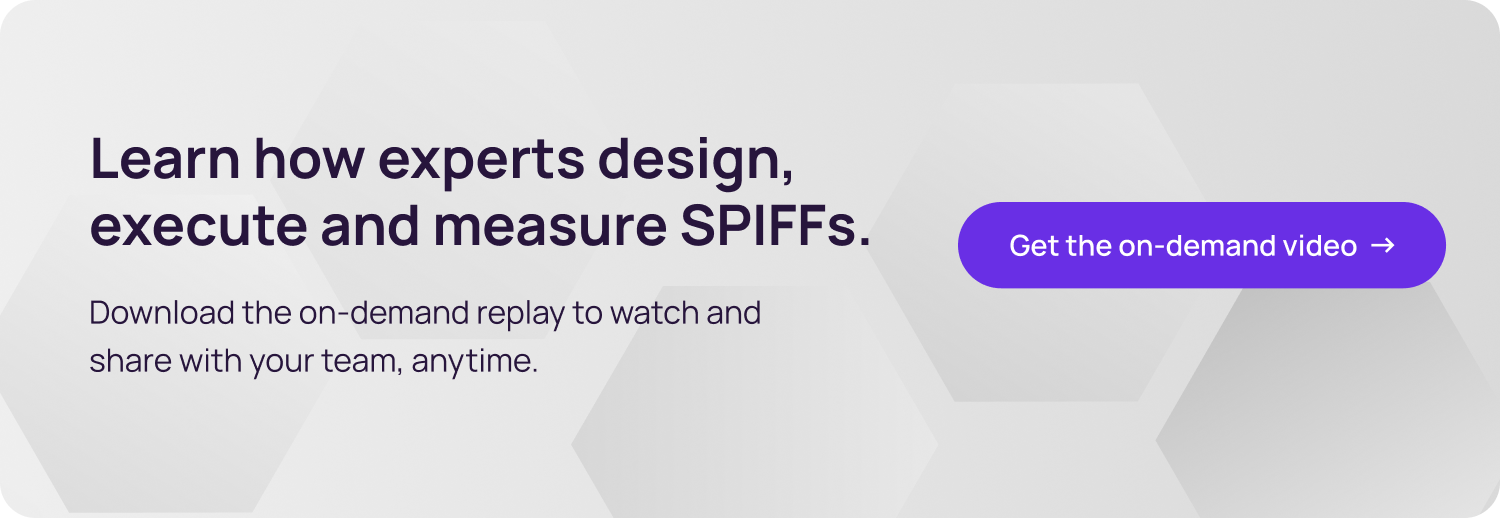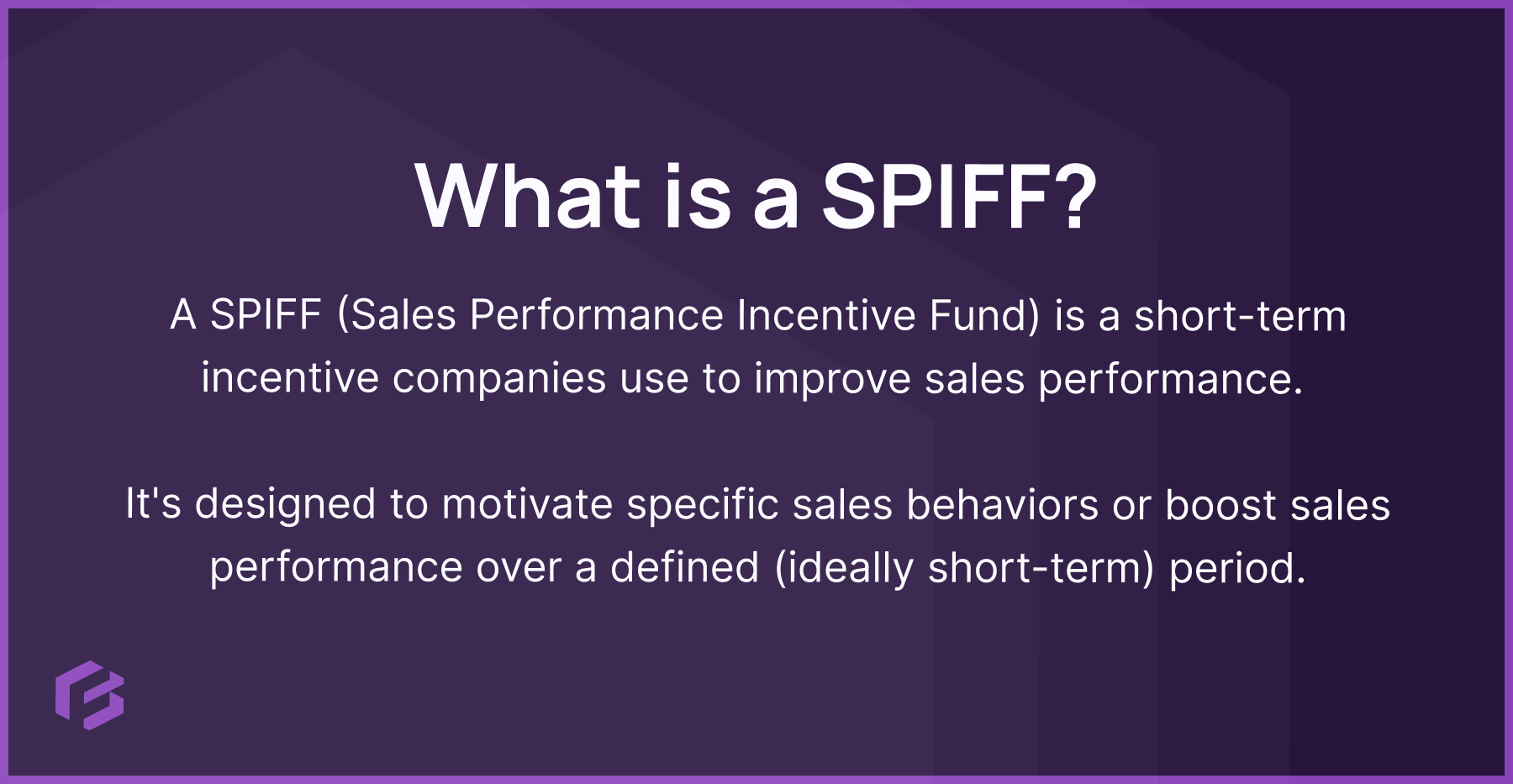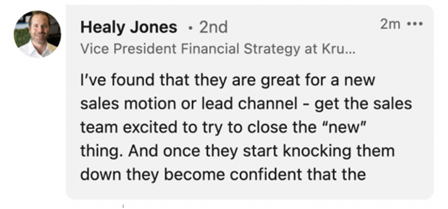.png)
The expert guide to SPIFFs: Sales incentives explained via industry leaders
.png)
The expert guide to SPIFFs: Sales incentives explained via industry leaders
Learn exactly what a SPIFF is, how to design and budget for them, and mistakes to avoid. With examples, videos, and expert insights from HubSpot, Autodesk and more.
.png)
The expert guide to SPIFFs: Sales incentives explained via industry leaders
Learn exactly what a SPIFF is, how to design and budget for them, and mistakes to avoid. With examples, videos, and expert insights from HubSpot, Autodesk and more.
.png)
The expert guide to SPIFFs: Sales incentives explained via industry leaders
Learn exactly what a SPIFF is, how to design and budget for them, and mistakes to avoid. With examples, videos, and expert insights from HubSpot, Autodesk and more.
The expert guide to SPIFFs: Sales incentives explained via industry leaders
Learn exactly what a SPIFF is, how to design and budget for them, and mistakes to avoid. With examples, videos, and expert insights from HubSpot, Autodesk and more.
As any sales manager knows, short-term sales incentives can drive fast results—or backfire.
SPIFFs (Sales Performance Incentive Funds) are widely used in sales organizations, but they’re often misunderstood or poorly implemented. And the conventional advice out there? It’s outdated, oversimplified, or divorced from the realities of modern sales orgs.
So we built this guide differently.
We consulted four of the most respected experts in enterprise sales compensation to weigh in:
- Christina Straggas, Head of Global Sales Compensation at Equinix,
- Maria Oczko-Canant, VP, Sales Compensation & Planning, HP (previously Workiva),
- Kayla Thornton, Director, Incentive Compensation, HubSpot, and
- Meredith Noyes, Director, GTM Planning and Sales Incentive Compensation, Autodesk.
These are the compensation leaders designing SPIFFs at scale—for global sales teams, across complex compensation structures, with real revenue on the line.
What follows is a modern, practical guide to SPIFFs based on what these experts are actually doing: the frequency with which they run these incentives, how they budget, examples of SPIFFs, where they see them go wrong, how they avoid misfires, and how they test and evolve broader comp strategy.
Whether you’re rethinking your incentive mix, planning a mid-year push, or looking to hit your number without breaking the bank, this guide's for you

What is a SPIFF?
A SPIFF (Sales Performance Incentive Fund) is a short-term incentive companies use to improve sales performance. It's designed to motivate specific sales behaviors or boost sales performance over a defined (ideally short-term) period.

Unlike traditional commissions, which are steady and ongoing, the meaning of SPIFFs is all about immediacy. When we think about defining SPIFFs, our experts agree, they're:
- Targeted: Tied to a single action, behavior, or metric
- Short-term: Typically 2–4 weeks in duration.
- Tactical: Used to influence seller focus quickly.
According to our experts, they should also be a stretch goal that's not guaranteed (it's intended to boost your sales results beyond normal expectations).
Above all, SPIFFs should be used sparingly and strategically, ensuring they remain a surprise. Unpredictability is crucial; you want to avoid complacency as expectation from your sales team ends up diluting SPIFF effectiveness.
.png)
Overall, a well-designed SPIFF isn’t just about money—it’s about meaning (and critically, the recognition) that comes with hitting this well-defined goal.
Here's Meredith Noyes, Director of GTM Planning and Sales Incentive Compensation at Autodesk on three critical levers you can consider behind every strategic SPIFF:
- Duration
- Breadth
- Eligibility
Plus what she's seen work especially well in practice:
How long should you run a SPIFF for?
On duration in particular, Meredith advises:
Why SPIFFs work—and when they don't
SPIFFs work to spur sales performance because they activate urgency. When reps know there's a near-term reward tied to clear criteria, they focus—and act.
But the reverse is also true. Even well-intentioned SPIFFs can fail if they're unclear, misaligned, or seen as unattainable from the start.
The advantages of using spiffs
While not always the answer to motivating a team, when used appropriately, SPIFFs can have a huge impact. Done well, a SPIFF can:
- Re-energize performance during flat periods
- Direct rep attention toward high-priority initiatives
- Create momentum without long-term comp changes
Healy Jones, VP of Financial Strategy at Kruze Consulting, shared his take on the impact of using SPIFFs strategically:

In other words, you can use SPIFFs for new sales motions or lead channels. If you have identified a new untapped market, they can be a quick way to rally efforts and produce near-immediate results.
Poorly designed SPIFFs, however, often:
- Reward the wrong behaviors (e.g., volume over value)
- Cannibalize performance from other areas
- Create confusion and disengagement
Other common challenges teams face:
- Over-reliance on SPIFFs: When used too often, SPIFFs can distract from long-term performance and make reps dependent on short-term incentives. They should enhance—not replace—your core comp plan. These longer-term incentihould remain a hallmark of your incentive compensation plan instead.
- Diminishing returns: The motivational power of SPIFFs relies on novelty and urgency. If reps come to expect them regularly, the impact fades fast.
- Perceived unfairness: If only certain reps can realistically win (due to territory, timing, or access), SPIFFs can breed resentment. Structure SPIFFs to ensure broad eligibility and communicate rules and tracking transparently.
The different types of SPIFFs
SPIFFs aren’t one-size-fits-all. There are multiple ways to motivate and reward reps, depending on the behavior you're targeting and the environment you're operating in. Most fall into three practical categories:
1. Monetary SPIFFs
These are cash-based rewards, either as direct payouts or reloadable cards. These are simple and effective—especially when urgency is key.
2. Non-monetary SPIFFs
Used when reps are already well-compensated or when novelty drives more engagement. Examples include:
- Event tickets
- Travel or experiences
- Gift cards
- Electronics
- Paid time off
While some scoff at non-monetary SPIFFs, it's important to consider everyone has different motivators.
We learned during Maria and Christina's session, for example, that non-cash rewards often have a more lasting impact; imagine the allure of a weekend getaway, a high-tech gadget, or even a unique experience like a cooking class with a renowned chef? These rewards create memories and stories that go beyond a simple financial gain.
As Maria Oczko-Canant of Workiva shared:
Being able to share their experience in front of peers was incredibly impactful. It gave other reps—particularly those in the middle of the performance pack—a chance to learn directly from what worked. The recognition itself carried weight, and it became a vehicle for spreading best practices and lifting team performance as a whole.
3. Surprise SPIFFs
With this SPIFF type, the reward is left a mystery until the goal is complete. These can build excitement and engagement, particularly in hybrid or remote-first teams.
For distributed teams, consider using digital visibility tools—like Slack alerts or live leaderboards—to keep motivation high. You can also structure short contests (e.g., a "power hour") where teams compete in real time across locations.
You can also categorize SPIFFs by their trigger—what reps need to do to earn them:
- Volume-based: E.g., $100 per qualified demo
- Behavior-based: E.g., completing enablement tasks or CRM updates
- Outcome-based: E.g., first deal in a new vertical or closed-won in target segment.

How to design effective SPIFFs, every time
According to our experts, your SPIFFs should be:
- Specific: Target just one behavior or action
- Attainable: Hard but not out of reach
- Trackable: Easily measured and communicated
- Aligned: Complementary—not conflicting—with your core comp plan
To help ensure each of the following is true, start with these key steps:
1. Align SPIFFs to wider organizational goals
SPIFFs are a great way to reinforce broader sales organization initiatives, such as supporting a promotional pricing period for a critical product.
When you have transactional data you can rely on, it’s even possible to accurately forecast how much revenue SPIFs for new products will create.
Remember, just as not all overarching organizational goals are created equal—neither are SPIFFs. As it turns out, this is a great way to prioritize the types of SPIFFs you should run, too.
As Kayla Thornton, Director of Incentive Compensation at HubSpot explains, you'll often hear that SPIFFs should be complementary to your sales compensation plan, not duplicative. Here's her take on how to interpret that advice, and how HubSpot tiers its company objectives to isolate the sweet spot for strategic, time-bound incentives that drive action without disrupting core priorities:
2. Proactively plan your annual calendar of SPIFFs
SPIFFs that can be designed in advance should be — in detail — during annual planning and forecasting.
In fact, you'll want to run multiple SPIFFs throughout the year. Consider peaks and valleys in your businesses' annual calendar and how you could most influence these. This, so that your SPIFF program operates as an incentive roadmap that corresponds to critical milestones, seasonal variability, or market opportunities throughout the year.
For instance, in industries with seasonality, what might you do with a spiff designed for specific months when purchasing is expected to pick up? Think about this at the start of your annual planning and how you might ensure revenue over the course of the year with your limited spiff budget.
3. Allocate a specific budget relative to the overall compensation budget
Miscalculating the cost of a SPIF can quickly leave you without enough funds to support the intended outcomes.
The benefit of an integrated SPIF planning process is that you identify most of the SPIFs that will be rolled out during the year and can allocate the budget and model accruals forecasts accordingly. We get into how to budget for SPIFFs a little later on in this guide.
4. Make Comms to sellers a priority—From day one
The success of a SPIFF hinges on how clearly and consistently it's communicated.
From the outset, make sure every participant knows exactly what’s at stake: What’s the goal? Who’s eligible? How is success measured—and rewarded?
Work closely with sales leaders to build buzz and trust around the program. Outline how it connects to broader business objectives, and what actions reps need to take to win.
Throughout the SPIFF period, keep the momentum going with regular updates. Share progress toward targets, highlight top performers, and remind everyone what they’re working toward.
When the SPIFF wraps, close the loop:
- Share results with the team to reinforce its business impact.
- Ensure reps recognize when a SPIFF payout hits their paycheck—and what specific actions earned it.
Clear attribution helps connect the reward to the behavior, making it more likely to stick long-term.
Incentives only work if people understand them—so never treat communication as an afterthought.
5. Test and Experiment with SPIFFs (they can be your incentive innovation lab)
SPIFFs aren’t just about short-term motivation—they can also be a powerful testing ground for future compensation design.
Unlike permanent changes to your incentive comp plan, which may carry legal and administrative complexity (especially across global regions), SPIFFs offer a low-risk way to trial new ideas. Want to drive a new behavior? Reinforce a shift in GTM motion? See if a different KPI resonates with reps? A well-structured SPIFF lets you test the waters before rolling anything into the formal plan.
That’s exactly how Autodesk’s GTM Planning and Compensation team approaches it. As Meredith Noyes shared:
“You come up with an idea—‘we want to incentivize X, Y, or Z’—and instead of baking it directly into the comp plan, we start with a SPIFF...We get some data around that, and then we can use that data to inform comp design for the future.”
This pilot-style approach means you can:
- Validate incentive hypotheses before codifying them
- Gather real rep behavior and performance data
- Iterate quickly based on what’s working (and what’s not)
Even better? When supported by the right infrastructure, it’s fast. Autodesk has built a SPIFF-ready framework inside the Forma.ai platform, enabling their team to spin up targeted, trackable SPIFFs the moment an opportunity—or challenge—emerges.
Bottom line? Treat SPIFFs not just as tactical levers, but as a strategic sandbox—one where you can test ideas, measure impact, and make smarter long-term decisions about your sales comp plan.
5. Record outcomes and template your best-performing SPIFs
Although it’s hard to predict which products will miss sales targets, a framework for SPIFs can be created based on past offers and pre-built into the ICM. Historical SPIFs can be used to model the potential impact of the SPIF using the most current data.
To save time, create a library of successful SPIFs, particularly seasonal ones that repeat, instead of rewriting the book every year. Include frameworks and best practices that can be customized as needed, as well as other important information related to SPIF management. This way, you can quickly launch SPIFs throughout the year when needed.
Build out the more common and successful SPIFs while giving yourself the flexibility to change and build on them throughout the year.
Proactive vs. reactive SPIFFs: Why the best teams plan for both
There are two primary ways SPIFFs are typically used:
- Proactively: To boost performance in strategic areas or during seasonal lulls (consider SPIFFs planned for things like a product launch, quarter-end push, or key seasonal window)
- Reactively, To course-correct when things aren’t trending well or respond to in-quarter surprises or sales attainment gaps.
Each approach has merit—but also trade-offs. Which is why this topic often sparks debate among comp leaders.
The challenge? Proactive SPIFFs are seen as strategic and orderly—built into the calendar, tied to larger campaigns, and easy to communicate. Reactive SPIFFs, on the other hand, can feel like firefighting. When misused, they erode trust, distract from core goals, and create comp “noise” that’s hard to clean up.
But here's the nuance: just because a SPIFF is reactive doesn’t mean it’s unplanned—or ineffective. In fact, many high-performing teams build intentional reactivity into their compensation strategy.
Case in point: HubSpot’s Director of Compensation shared how their team treats reactive SPIFFs as a necessary tool—especially in a world where forecasts miss, product launches slip, and competitors undercut at the last minute.
The key isn’t choosing between proactive or reactive SPIFFs—it’s knowing how to use both with intention.
How to budget for SPIFFs
There’s no universal formula for SPIFF budgeting—but there are smart guardrails that top-performing teams use to stay strategic, not reactive. Here’s what our experts recommend:
1. Start with a global baseline
Most organizations allocate 5–10% of their total commissions budget specifically for SPIFFs. As Kayla Thornton and Christina Straggas shared with us, this provides enough flexibility to run meaningful short-term incentives throughout the year—without distorting the core plan.
This budget is often carved out centrally, then partially distributed to regional or sales leadership teams for localized execution. That said, autonomy should never mean an open faucet.
2. Structure incentives around projected ROI, not gut feel
When modeling SPIFF costs, many leaders take a percentage-of-revenue approach.
If a team is asking to launch a SPIFF, they’re expected to project the revenue it will drive—and fund the initiative accordingly.
https://www.youtube.com/shorts/cbB5RwB_QxE
SPIFFs should be treated like a performance investment. That means:
- Model the cost as a share of expected incremental revenue.
- Measure impact by comparing SPIFF-driven performance vs. baseline.
- Kill or adjust underperforming incentives quickly—if you’re not seeing momentum by week two, it may not be worth the spend.
3. Watch for “SPIFF Creep”
If too much of a rep’s earnings are coming from SPIFFs, it’s a red flag.
This ratio helps maintain focus on tier-one priorities while still allowing room for targeted experimentation and nudges.
4. Track incrementally, not just participation
A SPIFF that rewards activity that's already happening isn’t worth the spend. To keep budgets effective, always evaluate:
- What's concretely changed because of the SPIFF?
- Did we generate true incremental revenue—or just shift timing?
When used well, SPIFFs can be agile, powerful tools. But without a budget strategy and performance guardrails in place, they risk becoming expensive noise.
Real SPIFF examples in practice
The best examples of SPIFFs are tightly aligned to strategic goals—and built to encourage the right behaviors at both the individual and team level.
One example shared by Maria Oczko-Canant, Head of Global Sales Planning, Compensation and Performance Analytics at Workiva, involved a pipeline-building SPIFF, often referred to as a “prospecting blitz.” In this case, the goal was to strengthen early-stage funnel health during a slow demand period:
The structure of this SPIFF was particularly effective because it rewarded both individual achievement and team-wide success.
- Reps across inside sales, business development, and account executive teams earned personal bonuses for hitting prospecting milestones.
- But if the entire pod (a small, cross-functional sales group) hit their collective goal, a larger team reward kicked in.
This structure created energy, alignment, and—importantly—a measurable outcome: a stronger pipeline heading into the next quarter. Because the objective was targeted and trackable from the outset, it was easy to determine success and ROI.
SPIFF example ideas to inspire you
Here are a few high-impact SPIFF structures that follow best practices for clarity, alignment, and motivation:
The Pipeline Blitz
Objective: Run a short-term sprint to boost top-of-funnel activity.
➤ Two-week push offering $100 for every demo booked in a new vertical.
Result: a % increase in demo volume and early traction in a new market.
The 'LAUNCH IT" SPIFF
Objective: Drive early adoption and feedback for a recently launched SKU.
➤ Reward reps for the first 3 closed deals involving the new product line.
Result: Accelerated uptake and valuable frontline feedback loop.
A behavioral (tidy up) SPIFF
Objective: Encourage sales hygiene to improve forecast accuracy.
➤ $25 bonus for every opportunity updated with a valid close date within the next 30 days.
Result: Cleaner pipeline reviews and improved forecast reliability.
The cross-sell challenge
Objective: Promote broader product adoption across existing accounts.
➤ $200 bonus for each closed deal involving an add-on product or service.
Result: deeper customer value penetration.
The one-team-one-dream-SPIFF
Objective: Foster collaboration across roles.
➤ AE + BDR pairs that hit joint SQL + Closed Won targets unlock a tiered bonus.
Result: Stronger handoffs and tighter alignment between prospecting and closing motions.
When designed thoughtfully, SPIFFs don’t just drive results—they also reinforce your GTM motion and team culture. Whether you’re solving for pipeline gaps, product uptake, or data cleanliness, consider which behaviors need a nudge—and which format will drive the outcome you need.
FAQs
What does SPIFF stand for?
Sales Performance Incentive Fund.
“SPIF” or sometimes seen with double 'F' in its spelling is a backronym for “Sales Performance Incentive Fund.” A Sales Performance Incentive Fund is a short-term incentive or bonus for a sale that companies use to improve sales performance. These could be cash bonuses, prizes, gift cards, or a boost to regular commission payments.
According to an article on Wikipedia, the acronym originates back to a term used to describe “The percentage allowed by drapers to their young men when they affect the sale of old fashioned or undesirable stock.”
In a mid-19th century copy of the Pall Mall Gazette, an article mentions that spiffs were a secret code used on labels that told sales reps to push underperforming products on customers as the “most fashionable (spiffy)” accessory.
The next reference to ‘spiffs’ is in a London newspaper forty years later, where it is again used to indicate a tactic used for clearing stock.
How long should a SPIFF run?
Most run 2–4 weeks—long enough to create impact, short enough to drive urgency.
How is a SPIFF different from a bonus or draw?
SPIFFs are tactical, short-term motivators. Bonuses are often tied to longer-term results; draws are advance payments against future earnings.
Why don’t SPIFFs always lead to better sales outcomes?
Because they’re often reactive, rushed, and disconnected from the broader comp strategy. That can lead to poor design, misaligned behavior, and limited long-term impact.In fact, they are vulnerable to abuse (mostly when tracked manually). Lack of oversight or controls can open the door to manipulation or even fraud. You can automate SPIFF management with secure, auditable systems.
How often should you run SPIFFs?
Intentionally. A few times per year—aligned with business needs and sales calendar. Plan to run approximately 2-3 annually, ensuring they do not confuse your reps or divert attention away from the strategic objectives of the core compensation plan.
Can SPIFFs hurt team performance?
Yes—if they're confusing, unfair, or conflict with broader goals.









.avif)


